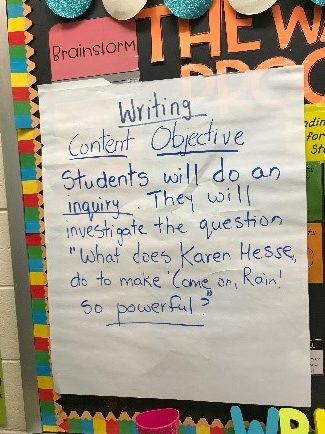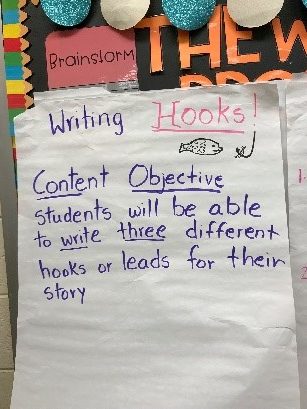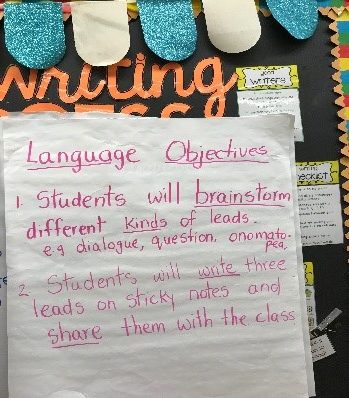How to Plan to Continuously Incorporate Target Words Throughout the Dayvpk Classroom
Just as travelers need a map or a GPS to help them find their way to their destination, likewise students also need to be explicitly told what the final objective of the lesson is, and how the teacher would like to see the students achieve it. Research has shown that objectives help both teacher and students focus attention on what is most important to learn (Duchastel, 1979; Marzano, Pickering,&Pollack, 2001). Supplying objectives in advance gives students a clear direction and something to work toward (Woolfolk, 2001). Teachers of English Language Learners (ELLs), especially, must be very explicit in developing purposeful objectives. This helps students to stay focused on the instructional path and not wander aimlessly, not knowing their purpose. ELLs need both language and content objectives; teachers should give them both within a limited amount of time (Echevarria, Vogt, & Short, 2008).
Learning Objectives are also important because the introduction of WIDA standards for English Language Learners has resulted in an increase in rigor and a focus on academic language. With this shift, the language service models that isolate language development from content have given way to co-taught classrooms where everyone is exposed to the same academic language with scaffolded content instruction.
Research has shown that it is very important for ELLs to be exposed to academic language and that language taught through content instruction is far more beneficial to the ELL students. It is difficult to teach content to newcomers who come with no or very limited English proficiency, but it can and should be done. By using visuals, sentence frames, word banks, or even rewriting the chapter of the novel in language that is more comprehensible (as a scaffold into grade-level text), content can be taught without watering it down. The student can also listen to the book or have it read aloud to him or her to scaffold their own engagement with the text. I have a student in fourth grade who has very limited academic English (although his social language is good). I select six vocabulary words (from the fifteen that the rest of the class does) and use visuals and simpler definitions to help him understand the words. I pick words that would help him not only understand the text but also help him in other academic areas, too.
What are Learning Objectives?
There are two important and distinct Objectives:
- Content Objectives
- Language Objectives
Content Objectives identify what students should know and be able to do at the end of the lesson. These objectives will frequently be used to form assessments. They are derived from the core standards. They focus on the "What."
Language Objectives are "how" the students will show what they are learning. They are focused on the four domains of Speaking, Listening, Reading, and Writing. The ELP (English Language Proficiency) standards and the WIDA standards are sources of language objectives. The WIDA consortium has compiled a list of "Can Do" descriptors that can help teachers identify the kind of language tasks students should be able to perform according to the five differing levels of English proficiency and different grade-level clusters. To view these descriptors, visit the "Can Do" page on the WIDA website.
Planning language objectives isn't always an easy, straightforward process. It has to be based on the students' needs. Here are some questions that could help you develop language objectives:
- What language forms or structure are students struggling with?
- What language functions do they need to access content learning?
- What gaps most need to be filled?
- What will increase their fluency?
- What will help prepare students for the next proficiency level?
Here are some examples:
Key:
Content-Bold
Language function- Italicized
Language structure- Underlined
- Students will be able to identify the main idea and three supporting details from the text by using the sentence stem, "The main idea is ___________. Three supporting details are ____."
- Students will be able to solve two-step equations "using inverse operations."
I focus on one or two language and content objectives and keep my wording of it as student friendly as possible. The objectives could be for a day, for a week, or for an entire lesson. I initially started incorporating content and language objectives only for Reading, but I found they were equally powerful when used with Writing lessons.
Here are some examples of Content and Language Objectives that I used in my third grade co-teach classroom:





Other Examples of Content and Language Objectives:
Content Objective: "Students, today you will learn about the causes of the American Revolution."
Language Objective: "Students will be able to orally explain the connection between the French and Indian War and the American Revolution."
Content Objective: "Students will find the lowest common denominator (LCM) of two or more numbers."
Language Objective: "Students will write the steps used to solve the problems."
Verbs for Writing Content and Language Objectives based on Bloom's Taxonomy and the four domains of language:
Verbs for Content Objectives:
Knowledge- list, describe, identify
Comprehension- summarize, explain, recall
Application- compare, contrast, classify, solve
Synthesis- compose, create, infer, elaborate
Evaluation- recommend, justify, support, defend
Verbs for Language Objectives
Listening-identify, tell, show
Speaking- discuss, explain, summarize, ask and answer questions
Reading-find specific information, preview, read aloud or with a partner
Writing- summarize, provide evidence to support your answer, state and justify opinions
My Personal Experience using Content and Language Objectives:
Our school district has recently introduced the Sheltered Instruction Observation Protocol (SIOP) model of instruction, and one of the strategies that SIOP considers as part of best teaching practices is introducing Learning Objectives before the lesson is taught. We follow the push-in, co-teach model in our district and I have been using the Learning Objectives in a 3rd grade classroom for ELA and Writing. I have found that periodically reviewing the content and language objectives with the students has helped them to stay focused on what they are expected to learn. I also ask them to read the objectives back to me and I ask questions to clarify their understanding of the objectives. Posting the objectives has helped the classroom teacher and me to focus on the students who are struggling in specific areas like comprehension, sentence structure,or vocabulary development. The objectives have also helped us to create assessments .
I have also found that language objectives are beneficial not only for ELLs but also for all students, as everyone can benefit from the clarity that comes with a teacher outlining the requisite academic language to be learned and mastered in each lesson.
As an ELL teacher, I am able to identify my ELL students' language proficiency to determine appropriate language objectives. I am also able to differentiate the Language Objectives for my ELL students, while keeping the content objectives the same. We do not post the differentiated language objectives in the classroom, but during our lesson planning, the classroom teacher and I decide how we will differentiate the language objectives for the ELLs and other struggling students. For example, I have an ELL student in third grade, who recently moved from another state. She is a level 3 in Oral Proficiency but is a level 1/2 in Reading and Writing. The classroom teacher and I provide her with word banks and sentence frames to help her meet the content and language objectives. I also provide other forms of support, like small group instruction and modified assessments, for her and a few other ELLs.
The writing of objectives have also helped us as a classroom management tool. We use them to make sure we are not sidetracked by other conversations. The objectives have also helped my co-teacher and me to periodically review the progress in meeting our objectives. Are they being met? If they are not, we know we have to teach it differently or change the objective to suit the needs of the students. The language objectives particularly have to be student-driven. We have determined that our students struggle with summarizing and providing evidence to support their answers, so that is a language objective we have been focusing on as we do our ELA unit this quarter.
Finally, Dr. Cynthia Lundgren, an English Language Development Specialist, sums it up well, "One of the most powerful ways to change teacher instruction is to look at content and language objectives. And with the standards, we're in a standards-based movement, we have great state to national standards. So these are available to teachers, they don't have to reinvent the wheel. But they often have to break them down into what is going to be accomplished during a unit, during a week, during a day. And then the next step is to look at the language that's expected of that because everything that we teach kids and expect them to do is through the medium of language. It's listening; it's responding, it's reading, it's writing. So what do we need to do to make sure that the reading, writing, listening, speaking is an open pathway to the content? And writing language objectives and content objectives is one way to keep on track."
References:
Making Content Comprehensible for English learners: The SIOP Model- Jana Echevarria, Mary Ellen Vogt, Deborah J. Short
https://ellevationeducation.com/blog/crafting-language-objectives-support-english-language-learners-ells
http://wp.lps.org/isell/blog/2014/06/06/content-and-language-objective-examples/
http://www.colorincolarado.org/article/language-objectives-key-effective-content-area-instruction-english-learners
Dr.Cynthia Lundgren, English Language Development Specialist
Source: https://achievethecore.org/peersandpedagogy/using-content-and-language-objectives-to-help-all-students-in-their-learning/

0 Response to "How to Plan to Continuously Incorporate Target Words Throughout the Dayvpk Classroom"
Post a Comment